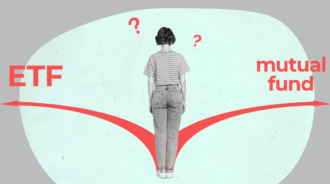

Mutual funds and Exchange Traded Funds (ETFs) are vehicles that offer investors the possibility of diversifying their portfolios. However, the difference between these two investment products is wide. In this article, we will understand what advantages of ETFs vs. mutual funds and which of these are better to invest in, whether you are in India or another country.

ETFs vs. Mutual Fund: an overview
There are many common factors in Mutual Funds and Exchange Traded Funds (ETFs). Both types of funds comprise a blend of various resources. ETFs and stocks additionally have a few differences. The major difference is that ETFs can be traded intraday like stocks, while mutual funds can only be bought at the end of the trading day based on the net asset value.
A Mutual fund is based on a strategy where an organization gathers funds from many individuals and puts them in stocks, bonds, or different resources. ETF stands for Exchange-traded funds, which means reserves for any exchange on trades. When you put resources or invest in an ETF, you get a heap of resources you can trade during market hours, bringing down the risk and expanding your portfolio.
The first mutual fund was launched in 1924, and it is present in its current structure have been around for very nearly a hundred years. ETFs are newer entrants to the market: the first one, the SPDR S&P 500 ETF Trust (SPY), was launched in January 1993.
The US is the world’s biggest market for common assets or mutual funds and ETFs, representing 48.1% of complete overall resources of $71.1 trillion in controlled open-end holdings as of December 2021.
As per the Speculation Organization Foundation, in 2021, U.S. Enrolled common assets, or mutual funds, had $27 trillion in resources, contrasted and $7.2 trillion in resources for U.S. ETFs. At year-end 2021, there were 8,887 shared reserves and 2,690 ETFs in the U.S.
Mutual Funds
Mutual funds are the most common type of investment. They are a type of investment fund managed by a professional investment manager. Mutual funds are a popular way for individuals to invest in the stock market or other assets because they typically offer a low-cost way to buy into large companies and their stocks. Mutual funds are a proven way to diversify a portfolio while staying within the same general risk profile.
Mutual stocks are either open-ended — trading is between buyers and the fund, and the range of shares to be had is countless, or closed-end — the fund issues a hard and fast number of stocks regardless of investor call.
Mutual fund managers try to match the risk level of their client’s portfolios. They do this by matching their client’s risk tolerance with specific types of investments, such as stocks or bonds. For example, a “conservative” investor might prefer a higher return potential with lower risk than an “aggressive” investor who wants a higher return potential.
Classification of mutual funds
Mutual funds can be classified in wide varieties to fulfill the requirements and expectations of different investors based on:
- Organization structure or association design:
- Open-ended;
- Close-ended;
- Interval.
- The board of portfolio:
- Actively;
- Passively.
- Investment goals:
- Development;
- Pay/Income;
- Liquidity.
- Fundamental portfolio:
- Equity;
- Debt;
- Hybrid;
- Currency market instruments;
- Multi Resources.
- Topical/arrangement situated:
- Assessment saving;
- Retirement benefit;
- Child welfare;
- Exchange.
Exchange-traded funds (ETFs)
Exchange Traded Funds (ETFs) are a type of investment fund that trades on a stock exchange. They invest in various securities, such as stocks and bonds, making them more flexible than mutual funds. ETFs can be traded like stocks and bonds or bought and sold like mutual funds.
Some ETFs track indexes such as the S&P 500 or the Dow Jones Industrial Average. Others track individual stocks, bonds, or sectors within an economy, such as technology or energy.
Exchange-traded funds can cost less to enter a position as they can be purchased in bulk. They trade throughout the day like stocks and are created or redeemed by institutional investors. Like stocks, they can be sold short, making them appealing to speculators but less so to long-term investors.
Types of ETFs or Exchanged traded funds
There are five types of ETFs:
- Equity ETFs are funds that track the performance of an index. They tend to have similar trading characteristics to index mutual funds, but they trade on the open market and can be bought and sold like stocks.
- Debt ETFs are funds that invest in bonds of various types. They tend to be more conservative than equity ETFs and typically have lower volatility than equity ones.
- Gold ETFs are trade exchanged reserves that track the cost of gold. They expose investors to the price of gold, an essential commodity for monetary and economic stability typically used as a reserve currency and a medium of exchange.
- Global ETFs is a fund that invests in other global equity markets outside the United States. You can invest in it just like any other ETF, but it will have exposure to foreign equities and some currency exposure.
- Smart beta ETFs are a relatively new investment strategy that uses market-cap-weighted indexes to offer investors exposure to various asset classes, including stocks, bonds, and real estate. This type of ETF is also known as “smart beta” because it attempts to mimic the performance of an index that reflects the characteristics of the market or asset class.

What are the differences between ETFs and mutual funds?
A major difference between exchange-traded funds and mutual funds is that ETFs can be sold and offered similar to stocks, while mutual funds can handiest be purchased on the giving up of every buying and selling day.
Actively managed mutual funds tend to have better fee ratios than ETFs, reflecting the better working expenses in lively management.
Which one is better: an ETF or a mutual fund?
The advantages of ETFs as compared to mutual funds are:
- ETFs are free to trade: you can buy or sell your position anytime, day or night.
- ETFs are cheaper than trade stocks because the daily management fee is lower than most stock mutual funds.
- ETFs provide diversification benefits, as they hold a variety of securities across many asset classes and geographic regions rather than just one type of security (such as government bonds).
Are ETFs risker than mutual funds/common assets?
While ETFs and mutual funds that, in any case, follow a similar methodology or track an equal index are built a little differently, there is no obvious evidence to accept that one is innately more hazardous than the other. The fund’s riskiness depends more on underlying holdings than the investment structure.
Conclusion
Investors can combine ETFs and mutual funds to construct a diversified portfolio. However, it is essential to evaluate the market risks. Investment in mutual fund units implies speculation dangers, for example, settlement, liquidity, and default risks, including the potential loss of capital. Before investing in any fund, it is helpful to consult with a stock market advisor.








